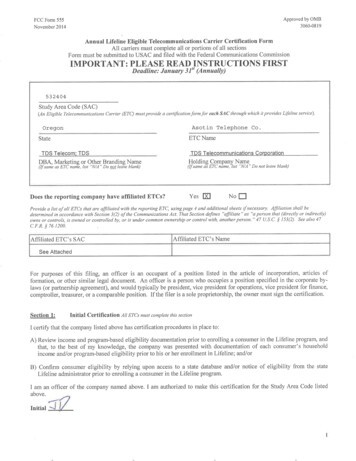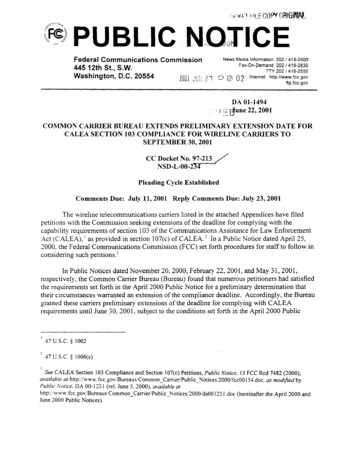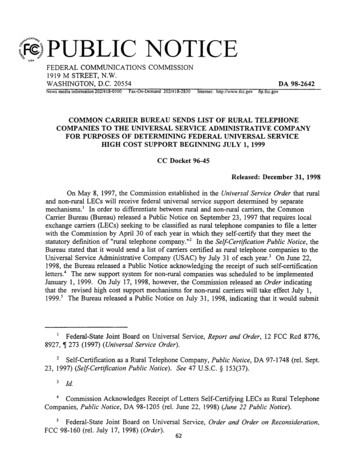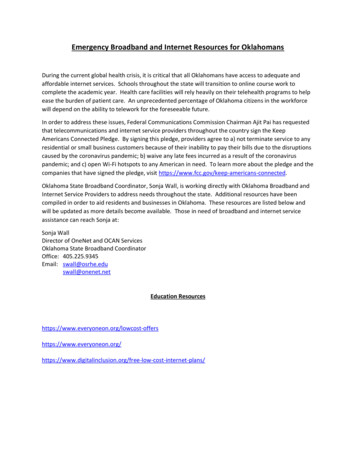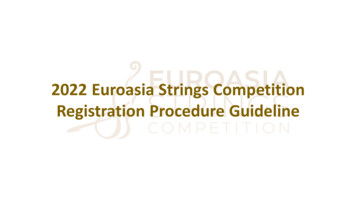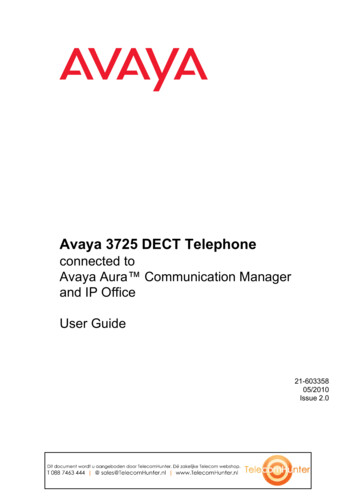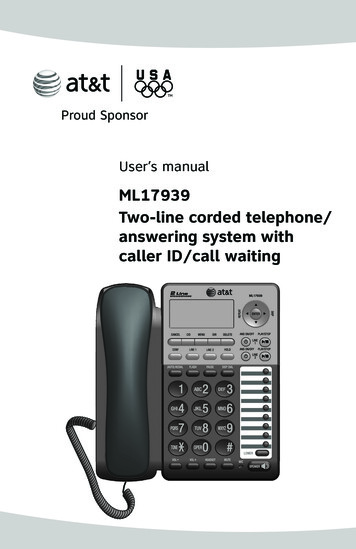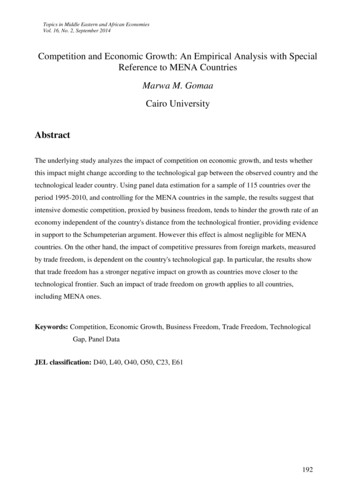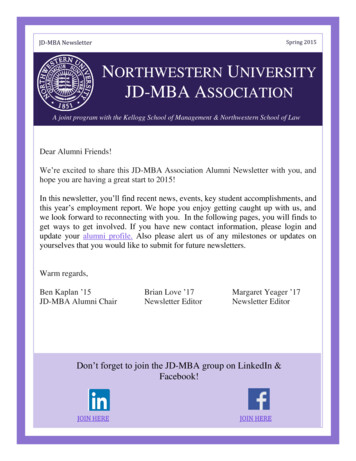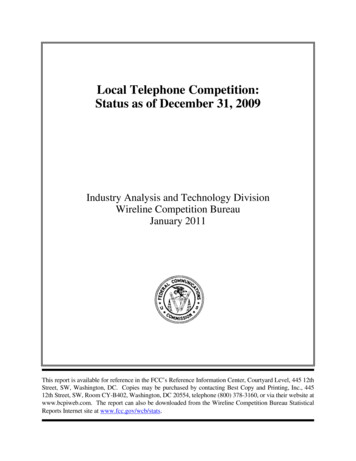
Transcription
Local Telephone Competition:Status as of December 31, 2009Industry Analysis and Technology DivisionWireline Competition BureauJanuary 2011This report is available for reference in the FCC’s Reference Information Center, Courtyard Level, 445 12thStreet, SW, Washington, DC. Copies may be purchased by contacting Best Copy and Printing, Inc., 44512th Street, SW, Room CY-B402, Washington, DC 20554, telephone (800) 378-3160, or via their website atwww.bcpiweb.com. The report can also be downloaded from the Wireline Competition Bureau StatisticalReports Internet site at www.fcc.gov/wcb/stats.
ContentsTEXTIntroduction.1Explanation of terminology used in this report.2Data interpretation .2Wireline retail local telephone service.2Service providers .4Interconnected VoIP service .7Switched access lines .10Wholesale relationships for switched access lines.10Remainder of the report .12FIGURES1. Interconnected VoIP Subscriptions and Retail Switched Access Lines, 2008 - 2009.32. Wireline Retail Local Telephone Service Connections by Technology andCustomer Type .43. Wireline Retail Local Telephone Service Connections by Customer Type andRegulatory Status .54. Wireline Retail Local Telephone Service Connections by Technology, Regulatory Status,and Customer Type .65. Interconnected VoIP Subscribership by Reported Service Features .86. Technology of Internet Access Connections in Interconnected VoIP Broadband Bundles .97. Technology of Retail Switched Access Lines .108. Wholesale Relationships as Reported Respectively by CLECs and ILECs .11TABLES1. End-User Switched Access Lines and VoIP Subscriptions.132. End-User Switched Access Lines and VoIP Subscriptions by Customer Type .143. End-User Switched Access Lines and VoIP Subscriptions Reported by Non-ILECs.154. ILEC End-User (Retail) and Wholesale Switched Access Lines, VoIP Subscriptions,and UNEs .165. End-User Switched Access Lines and VoIP Subscriptions by Type of Technologyfor Non-ILEC Providers .176. Percentage of Switched Access Lines Presubscribed for Long Distance Service.187. Residential and Business Presubscribed Switched Access Lines.198. Total End-User Switched Access Lines and VoIP Subscriptions by State .209. Residential End-User Switched Access Lines and VoIP Subscriptions by State.2110. Business End-User Switched Access Lines and VoIP Subscriptions by State.22U.S. Federal Communications CommissionLocal Telephone Competition: Status as of December 31, 2009 i
11. Non-ILEC Share of Total End-User Switched Access Lines and VoIP Subscriptionsby State .2312. Non-ILEC Total End-User Switched Access Lines and VoIP Subscriptions by State .2413. ILEC Total End-User Switched Access Lines and VoIP Subscriptions by State .2514. Non-ILEC Methods of Providing Wireline Telephone Services by State .2615. Percentage of End-User Switched Access Lines and VoIP Subscriptions Provided toResidential Customers by State .2716. Number of Reporting ILECs, Non-ILECs, and VoIP Providers by State .2817. Mobile Telephone Facilities-based Carriers and Mobile Telephony Subscribers .2918. Percentage of ZIP Codes with CLECs or Non-ILEC VoIP Providers.3019. Percentage of Households in ZIP Codes with CLECs or Non-ILEC VoIP Providers .3020. Percentage of ZIP Codes with CLECs or Non-ILEC VoIP Providers by State .31CHARTS1. End-User Switched Access Lines and VoIP Subscriptions.132. Percent of Lines and VoIP Subscriptions that Serve Residential Customers .143. Non-ILEC End-User Switched Access Lines and VoIP Subscriptions.154. ILEC Total Lines and the Percent Provided to CLECs .165. End-User Switched Access Lines and VoIP Subscriptions by Type of Technologyfor Non-ILEC Providers .176. Percent Presubscribed Interstate Long Distance Lines for ILECs.18MAPReporting Non-ILEC Interconnected VoIP Providers and CLECsby 5-Digit Geographical ZIP Code .32U.S. Federal Communications CommissionLocal Telephone Competition: Status as of December 31, 2009 ii
Local Telephone Competition: Status as of December 31, 2009Introduction. This is the third of our reports about local telephone service in the United States thatincludes comprehensive information about subscribership to interconnected Voice over Internet Protocol(“interconnected VoIP”) service as well as comprehensive information about the more traditionaltelephone service lines.1,2 The report summarizes data collected by FCC Form 477 as of December 31,2009.We include certain ZIP Code-based information in the report.3 At present, there is no Form 477requirement to report any telephone service information at the census tract level of detail.4 We alsoupdate summary statistics for the mobile telephony subscribership information collected by Form 477.51The first such comprehensive report, which was released in June 2010, is available athttp://www.fcc.gov/wcb/iatd/comp.html. It contains more extensive citations for the Commission’s adoption, in2008, of improvements to the FCC Form 477 data collection program, which made reporting mandatory forproviders of retail interconnected VoIP services as well as for local exchange carriers and facilities-based providersof mobile telephony service. Qualifying entities file FCC Form 477 each year on March 1 (reporting data for thepreceding December 31) and September 1 (reporting data for June 30 of the same year). The first data collected onForm 477 were for December 31, 1999. Effective with the filing of data as of December 31, 2008, Form 477 is aWeb-based electronic filing system. Information about the filing system and the Form 477 program generally isavailable at http://www.fcc.gov/form477/.2The FCC’s rules (at 47 C.F.R. § 9.3) state:An interconnected Voice over Internet Protocol (VoIP) service is a service that:(1) Enables real-time, two-way voice communications;(2) Requires a broadband connection from the user’s location;(3) Requires Internet protocol-compatible customer premises equipment (CPE); and(4) Permits users generally to receive calls that originate on the public switched telephone network and toterminate calls to the public switched telephone network.We note that the current interpretation of element (4) of the definition excludes the VoIP services that Skype offersin the United States, and subscribers to those services are not reported on Form 477. Prior to the December 2008data, companies such as Vonage that solely provide interconnected VoIP service did not file Form 477. Telephonecompanies and cable companies that provided local exchange telephone service were required to file Form 477 butwere not required to report interconnected VoIP subscriptions. However, some of these companies chose to includeinterconnected VoIP subscriptions in the number of retail (end-user) switched access lines that they reported.3Wireline service providers report whether they have at least one residential or business customer in each ZIPCode, using either switched access or interconnected VoIP. Because providers may not offer service across anentire ZIP Code and because different providers may target different customer segments in areas where they provideservice, we cannot conclude that the number of providers identified as delivering wireline service within a ZIP Coderepresents the number of options available to any specific customer within that ZIP Code. We further note thatthese data on the number of providers in a ZIP Code do not indicate whether a particular provider is offering servicesolely over its own last-mile facilities or is using the facilities of another carrier or entity.4This contrasts with the census tract-based broadband reporting requirements the Commission adopted in 2008, atwhich time the Commission sought comment about requiring local exchange carriers and interconnected VoIPservice providers to report the number of voice telephone service connections, and the percentage of these that areresidential, at the 5-digit ZIP Code or census tract level of detail. See Development of Nationwide Broadband Datato Evaluate Reasonable and Timely Deployment of Advanced Services to All Americans, Improvement of WirelessBroadband Subscribership Data, and Development of Data on Interconnected Voice over Internet Protocol (VoIP)Subscribership, WC Docket No. 07-38, Further Notice of Proposed Rulemaking, 23 FCC Rcd 9691 (2008) at 9708,para. 33.U.S. Federal Communications CommissionLocal Telephone Competition: Status as of December 31, 2009 1
Explanation of terminology used in this report. We use “Non-ILEC” to refer to any service provider who does not have incumbent localexchange carrier (ILEC) regulatory status, including, for example, competitive local exchangecarriers (CLECs), including both those who provide service over their own facilities and thosewho employ ILEC facilities or services, cable companies without CLEC regulatory status whoprovide interconnected VoIP service, and over-the-top (OTT) interconnected VoIP providers whoneither own nor operate telecommunications facilities.All “VoIP subscriptions” discussed in this report are interconnected VoIP subscriptions.When referring specifically to ILECs, we use the term “total lines” to mean the sum of ILECreported retail (end-user) switched access lines, ILEC interconnected VoIP subscriptions, andILEC wholesale switched access lines and unbundled network elements (UNEs) provided toCLECs.We specify “RBOC” and “Other ILEC” when we wish to distinguish between informationreported by the Regional Bell Operating Companies (that is, AT&T, Qwest, and Verizon)operating in their respective ILEC service areas and information reported by all other ILECs as agroup.Data interpretation. Lines from CLECs who have ILEC affiliates are handled at the state level in one of several ways.We place the lines into the non-ILEC category if the affiliate is an ILEC other than AT&T orVerizon. Lines from CLEC affiliates of AT&T and Verizon are allocated between the ILEC andnon-ILEC categories based on staff estimates if the CLEC operates in the AT&T or VerizonILEC service area in the state, respectively.When counting service providers who have any retail customers in a particular geography (forexample, a state or a ZIP Code), we count a holding company or common-control entity no morethan once in any specified sub-category of total providers.Nationwide counts of providers are unique counts for any specified sub-category of totalproviders (for example, all non-ILECs or all interconnected VoIP providers); an entity operatingin multiple states is counted only once.Wireline retail local telephone service. Retail local telephone service customers are served by twowireline technologies – “end-user” switched access lines and interconnected VoIP “subscriptions.” TheForm 477 program counts lines and subscriptions as the maximum number of voice calls that can beactive at one time from the retail customer’s location (for example, a business customer’s premises) underthe service plan that the end user has purchased from a local exchange carrier or interconnected VoIPservice retailer.6(Continued from previous page)5The presentation of mobile wireless telephone subscriber counts in this report does not constitute, or imply,Commission analysis of the extent to which wireline and mobile wireless telephone services are demand substitutesor complements in general or in any particular situation. In the Form 477 program, commercial mobile radioservice (CMRS) carriers who own or operate wireless networks report both their retail telephone service customersand the retail customers of mobile wireless telephone service resellers.6Form 477 data may not count all VoIP phone connections to Internet Protocol Private Branch Exchange (IP PBX)equipment that is owned by business end users because of the variety of ways the IP PBX may connect to the publicswitched telephone network.U.S. Federal Communications CommissionLocal Telephone Competition: Status as of December 31, 2009 2
In December 2009, there were 127 million end-user switched access lines in service and 26million interconnected VoIP subscriptions in the United States, or 153 million wireline retail localtelephone service connections in total. See Figure 1. Between December 2008 and December 2009 – the first full year of mandatory interconnectedVoIP reporting – interconnected VoIP subscriptions increased by 22% (from 21 million to 26million) and retail switched access lines decreased by 10% (from 141 million to 127 million).The combined effect was an annual decrease of 6% in wireline retail local telephone serviceconnections (from 162 million to 153 million). See Figure 1.Figure 1Interconnected VoIP Subscriptions and Retail Switched Access Lines, 2008 - 2009(In Thousands)200,000150,000100,00050,0000Dec 2008Jun 2009Dec 2009Interconnected VoIPSubscriptions21,27423,46225,981Retail SwitchedAccess Lines140,996133,262127,136 Of the 153 million wireline retail local telephone service connections in December 2009, 91million (or 59%) were residential connections and 62 million (or 41%) were businessconnections. See Figure 2. Cross-classified by technology and customer type, the 153 million wireline retail local telephoneservice connections in December 2009 were: 45% residential switched access lines, 38%business switched access lines, 15% residential interconnected VoIP subscriptions, and 2%business interconnected VoIP subscriptions. See Figure 2.U.S. Federal Communications CommissionLocal Telephone Competition: Status as of December 31, 2009 3
Figure 2Wireline Retail Local Telephone Service Connections by Technology andCustomer Type as of December 31, 2009 (In Thousands)Switched 1153,117TotalFigures may not add to totals due to rounding.VoIP, 38%VoIP,Residential15%Service providers. The retailers of wireline local telephone service include a variety of entities that aresubject to different federal communications regulation. The Form 477 program – and this report –distinguishes ILEC operations from all other operations. Generally, ILEC operations are more closelyregulated than non-ILEC operations because they operated as local monopolies for many years. After theTelecommunications Act of 1996 became law, some ILECs established CLEC affiliates (usually within aholding company or common-control structure) that compete against other ILECs. Also, some ILECshave acquired CLECs. In particular, RBOCs AT&T and Verizon have acquired major CLECs thatoperated within their ILEC service areas and elsewhere.7 With this overview as background, we report:7Qwest is the third of the three surviving RBOCs.U.S. Federal Communications CommissionLocal Telephone Competition: Status as of December 31, 2009 4
Cross-classified by customer type (residential or business) and the service retailer’s regulatorystatus (ILEC or non-ILEC), the 153 million wireline retail local telephone service connections(including both switched access lines and interconnected VoIP subscriptions) in December 2009were: 42% ILEC residential service, 28% ILEC business service, 17% non-ILEC residentialservice, and 13% non-ILEC business service. See Figure 3.Figure 3Wireline Retail Local Telephone Service Connections by Customer Type andRegulatory Status as of December 31, 2009 (In 153,117Figures may not add to totals due to rounding.Non-ILEC,Business13%ILEC, Business28% ally cross-classified by technology, the 91 million wireline residential connections inDecember 2009 were: 69.9% ILEC switched access lines, 23.5% non-ILEC interconnected VoIPsubscriptions, 5.5% non-ILEC switched access lines, and 1.1% ILEC interconnected VoIPsubscriptions. Similarly, the 62 million wireline business connections were: 68.0% ILECswitched access lines, 26.3% non-ILEC switched access lines, 4.8% non-ILEC interconnectedVoIP subscriptions, and 1.0% ILEC interconnected VoIP subscriptions. See Figure 4.U.S. Federal Communications CommissionLocal Telephone Competition: Status as of December 31, 2009 5
Figure 4Wireline Retail Local Telephone Service Connections by Technology, Regulatory Status,and Customer Type as of December 31, 2009 (In -ILECResidential TotalBusinessILECNon-ILECBusiness TotalSwitched 2976102,96442,80319,26158,4903,57462,064Figures may not add to totals due to rounding.ResidentialILEC, Switched69.9%Non-ILEC, VoIP23.5%Non-ILEC, Switched5.5%ILEC, VoIP1.1%BusinessNon-ILEC, VoIP4.8%Non-ILEC, Switched26.3%U.S. Federal Communications CommissionILEC, Switched68.0%ILEC, VoIP1.0%Local Telephone Competition: Status as of December 31, 2009 6
Interconnected VoIP service. Form 477 identifies three types of information about retail interconnectedVoIP service. First, interconnected VoIP service retailers distinguish between the interconnected VoIPsubscriptions they sell to their broadband Internet access service customers (“broadband bundle”8subscriptions, in this report) and all the other interconnected VoIP subscriptions that they sell9(“standalone” subscriptions). Second, filers report whether or not interconnected VoIP subscriptions include, as a servicefeature, the capability to use the service over any broadband connection to which the customerhas access, for example, at a hotel or vacation residence (“nomadic” functionality). Third, filers identify the different broadband technologies (for example, cable modem Internetaccess service) in the broadband bundle.The Form 477 data cross-classify the first two of these three sets of information. See Figure 5.8We note that the interconnected VoIP service “broadband bundles” reported on Form 477 do not need to be soldtogether for a single price, although they may be. The interconnected VoIP service and Internet access servicecould be marketed and billed by separate retailers, who are affiliated. The retailer of the Internet access servicecould either own the connection that delivers the service or be reselling Internet access service.9The “standalone” service might be OTT interconnected VoIP. It also might be interconnected VoIP sold by acable system operator as an individual service or in combination with cable TV service.U.S. Federal Communications CommissionLocal Telephone Competition: Status as of December 31, 2009 7
Figure 5Interconnected VoIP Subscribership by Reported Service Featuresas of December 31, 2009 (In PTotal5802,2852,864Not 2Not nomadic1,571#1,571ILEC Total1,58481,5925662,2772,843Not nomadic19,7231,82221,546Non-ILEC Total20,2904,09924,389ILECNomadicNon-ILECNomadic# Rounds to zero. Figures may not add to totals due to rounding.ILECBundle, Notnomadic98.7%Standalone,Nomadic0.5%Bundle, Nomadic0.9%Non-ILECBundle, Not nomadic80.9%Standalone, Nomadic9.3%Bundle, Nomadic2.3%U.S. Federal Communications CommissionStandalone, Notnomadic7.5%Local Telephone Competition: Status as of December 31, 2009 8
Form 477 collects the third type of information about retail interconnected VoIP service – the technologyof the Internet access connection – for broadband bundles but not for standalone interconnected VoIP.See Figure 6.10Figure 6Technology of Internet Access Connections in Interconnected VoIPBroadband Bundles as of December 31, 2009 (In Thousands)TechnologyDSL or Other WirelineFTTPCable ModemTerrestrial Fixed ,9272193Total2,61921318,92821931,58420,29021,874# Rounds to zero. Figures may not add to totals due to rounding.ILECCableModem0.1%DSL or OtherWireline96.6%FTTP3.3%Non-ILECCable Modem93.3%FTTP0.8%DS L or OtherWireline5.4%Other0.5%Terrestrial FixedWireless0.1%10“DSL” is Digital Subscriber Line technology, which typically delivers Internet access service over telephonecompany “local loops” (pairs of copper wires). The “Other Wireline” component of “DSL or Other Wireline”includes other ways of using telephone company local loops to deliver Internet access services, for example, over“T-1” circuits or Ethernet over copper. “FTTP” is fiber to the premises – optical fiber taken all the way to the enduser. “Cable modem” is the cable TV industry’s mass-market Internet access service, delivered to the end user overa coaxial cable. Terrestrial fixed wireless service makes a point-to-point connection between the service provider’santenna and an antenna installed at the end user’s premises.U.S. Federal Communications CommissionLocal Telephone Competition: Status as of December 31, 2009 9
Switched access lines. ILECs as a group predominantly deliver retail switched access lines overcopper local loops. This appears also to be the case for those non-ILECs who report retail switchedaccess lines. See Figure 7.Figure 7Technology of Retail Switched Access Linesas of December 31, 2009 (In Thousands)TechnologyFTTPCoaxial CableTerrestrial Fixed WirelessOther (copper local Figures may not add to totals due to rounding.ILECOther96.2%FTTP3.7%Non-ILECTerrestrial FixedWireless0.1%Coaxial Cable11.6%Other79.4%FTTP8.9%Wholesale relationships for switched access lines. ILECs typically own the communications facilitiesover which they provide retail services. By contrast, CLECs use a range of methods: equipping ILECUNE loops (“UNE-L”) as CLEC switched access lines,11 reselling services (for example, reselling ILEC11CLECs (as opposed to non-ILECs more generally) have certain regulatory rights to obtain ILEC local loops atcost-based UNE rates, which the CLEC may use to provide retail switched access lines or retail broadband Internetaccess connections. See C.F.R. § 51.307.U.S. Federal Communications CommissionLocal Telephone Competition: Status as of December 31, 2009 10
switched access lines obtained at wholesale rates or reselling ILEC lines obtained under commercialagreements that replaced the UNE-Platform (“UNE-P”)), equipping leased ILEC special access circuits asswitched access lines, and equipping local loops that the CLEC owns. At year-end 2009, CLECs reported using several methods to provide their 21 million retailswitched access lines. They reported providing 33% of lines (or about 7.1 million lines) byreselling ILEC wholesale or retail services. They reported providing 38% of lines (or about 8.2million lines) over ILEC facilities leased at regulated, cost-based rates (that is, as unbundlednetwork elements, or UNEs). And they provided the remaining 28% of lines (or about 6.0million lines) over local loops that they owned. However, the information about wholesalerelationships differs as reported by CLECs and by ILECs, as discussed in Figure 8.Figure 8Wholesale Relationships as Reported Respectively by CLECs and ILECsas of December 31, 2009 (In Thousands)CLECRetail SwitchedAccess Linesprovisioned overILEC Services(reported by CLECs)Resold ILEC services1UNE-P2UNE-L3Total ILEC UNEsTotal ILEC services7,1011,4466,7528,19915,299ILECWholesale SwitchedAccess Lines andUNEs provided toCLECs(reported by )3,0842,1356,243Figures may not add to totals due to rounding.1Resold ILEC services include switched access lines made available to CLECs at wholesale rates, resold Centrex,Integrated Services Digital Network (ISDN), or other ILEC services, ILEC special access circuits channelized toprovide CLEC retail switched access lines, and ILEC switched access lines provided to CLECs under commercialagreements that replaced UNE-P. (See note 2, below.) Filers are instructed to count the number of voice-gradechannels the retail customer purchased, not the theoretical capacity of the circuit over which the service was delivered.ILECs generally do not know (and do not report) which ILEC leased special access circuits or other high-capacitycircuits are being used to provide CLEC retail switched access lines (which the CLECs do report).2UNE-P was the combination of ILEC loop UNE, switching UNE, and transport UNE. The Commission directedCLECs to migrate their retail customers served by UNE-P to an alternative arrangement within 12 months of theeffective data of the Triennial Review Remand Order, that is, by March 11, 2006. See C.F.R. § 51.319(d)(2)(ii).3ILECs report the number of UNE-L they provide to CLECs but do not convert any high-capacity UNE-L, such asDS1 UNE loops, into voice-grade equivalents. By contrast, CLECs report the number of switched access lines theirretail customers purchase which the CLEC provisioned over UNE-L obtained from ILECs. Note, however, that aCLEC might use UNE-L only to provide broadband Internet access connections.U.S. Federal Communications CommissionLocal Telephone Competition: Status as of December 31, 2009 11
Remainder of the report. The remainder of the report consists of tables and charts that update andexpand data presented in earlier reports in this series. We present national data first, followed by statespecific data and, finally, summary statistics of the presence of competitors to the incumbent wirelinelocal telephone service providers in individual ZIP Codes.12****We invite users of this information to provide suggestions for improved analysis of data presented in thisreport by using the attached customer response form or by e-mailing comments to IATDreports@fcc.govfor subject: December 2009 local telephone data. We encourage users of this information to providesuggestions for improved data collection by participating in any formal proceedings undertaken by theCommission to solicit comments for improvement of FCC Form 477.12In any individual ZIP Code, the competitors to ILECs may be CLECs or interconnected VoIP providers who arenot affiliated with the ILEC, or ILECs, who serve end users in that ZIP Code. Appropriate interpretation of the ZIPCode-based information is discussed in n. 3, above.U.S. Federal Communications CommissionLocal Telephone Competition: Status as of December 31, 2009 12
Table 11End-User Switched Access Lines and VoIP Subscriptions(In Thousands)Provided byTotalNon-ILEC ShareILECNon-ILEC189,3974.3 8.1112,74843,976153,11729.8107,41
Local Telephone Competition: Status as of December 31, 2009 . companies such as Vonage that solely provide interconnected VoIP service did not file Form 477. . some of these companies chose to include interconnected VoIP subscriptions in the number of retail (end-user) switched access lines that they reported. 3 Wireline service providers .
